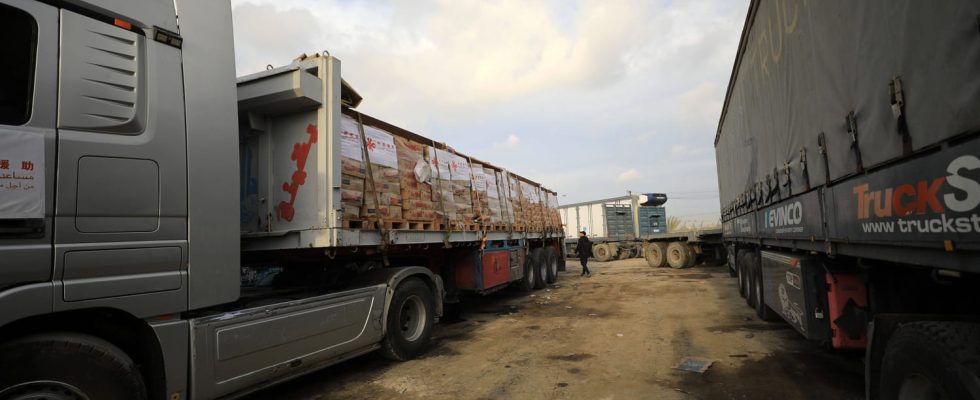The Israeli army has provided new information on the deadly incident that occurred during the distribution of aid in the Gaza Strip on February 29. 155 civilians were killed by the IDF according to Hamas.
A week after the scene of chaos during a distribution of humanitarian aid on February 29 in Gaza, the IDF provided details on the event on Friday March 8. That day, 115 people were killed according to Hamas authorities after Israeli soldiers “precisely shot several suspects”, according to the IDF. The Israeli army had in fact denied having carried out “limited shooting” on the crowd by which it had felt “threatened”. In a first statement, it was explained that “the examination carried out by the command revealed that the (Israeli) troops did not fire on the humanitarian convoy, but that they fired on a number of suspects who were were approaching (Israeli soldiers) and presented a threat.”
The IDF said in a new statement on Friday that “as the trucks were heading towards the distribution centers, a violent gathering of around 12,000 Gazans formed around them, who looted the equipment they ‘they carried’. The Israeli army explains that “during this looting, civilians were seriously injured and the trucks crushed them.” Residents of the Gaza Strip then “approached, at a distance of a few meters, the army forces and thus constituted a real threat to the forces present.” The IDF soldiers therefore allegedly shot at certain civilians to make them retreat and then continued to shoot “to eliminate the threat”, again according to the army.
The incident will be investigated, Israeli forces said, adding that they were making “many efforts to enable the transfer of humanitarian aid to the Gaza Strip.”
Two different versions
According to the Islamist group in power in the Gaza Strip, a crowd of hungry people rushed onto a convoy of trucks filled with food aid and secured by Israeli forces. The latter, according to Hamas and various testimonies from Palestinians, opened fire on civilians several times, causing many deaths and injuries. After the tragedy, the Israeli army assured, using drone images broadcast on social networks, that the incident occurred when Gazans surrounded the convoy and looted the humanitarian aid.
The very heavy toll drawn up by Hamas and the circumstances of the tragedy remain uncertain, but the incident provoked numerous and strong reactions internationally. Emmanuel Macron expressed his “deep indignation at the images reaching us from Gaza where civilians were targeted by Israeli soldiers” on X, former Twitter. “I express my strongest disapproval of these shots and demand truth, justice and respect for international law” added the President of the Republic, recalling that “all civilian populations must be protected” and that a “cease “The fire must be put in place immediately to allow humanitarian aid to be distributed.” “What is happening is indefensible and unjustifiable. This situation must end,” added the Minister of Foreign Affairs, Stéphane Séjourné, on France Inter. The minister also demanded “explanations and said that ‘an independent investigation will be needed to determine what happened.’
“112 dead and 750 injured” according to Hamas
Only the Hamas Ministry of Health provided figures after the shootings during the distribution of food aid. He speaks of a “massacre” which left “112 dead and 750 injured”. The American news agency Associated Press also counts more than 100 dead, but the number of victims still remains uncertain. Several hospitals in Gaza reported having received more than a dozen bodies and dozens of injured people, like the director of Kamal Adwan Hospital in Gaza City, Hussam Abu Safieyah. “We do not know how many other victims were taken to other hospitals,” he told Reuters. The Red Crescent humanitarian organization in Palestine told Al-Jazeera that 25 of its employees were killed in Thursday’s attack.
Strong international condemnations
The tragedy sparked strong reactions around the world. The spokesperson for the UN Secretary-General, Antonio Guterres, said he condemned the event. In France, the Quai d’Orsay expressed, in a press release, its “very deep emotion”. “The shooting by Israeli soldiers against civilians trying to access food is unjustifiable,” condemned Paris, which demanded that “all the light be shed”. On For its part, Turkey described the tragedy as “a new crime against humanity”, judging that this tragedy “is proof that[Israël] aims to consciously and collectively destroy the Palestinian people”. Unanimous condemnation also from the Arab countries of the Gulf. Finally, Washington declared to expect “answers” from its great ally Israel.
The beginnings of a famine in Gaza?
The shooting observed this Thursday came after the announcement of a new report by the Hamas Ministry of Health, according to which “more than 30,000” people have been killed in Israeli military operations in Gaza since the start of the war. , which broke out on October 7. American intelligence draws up an assessment of “more than 25,000 Palestinian women and children” killed since the start of the conflict, as the head of the Pentagon announced this Thursday, February 29. A figure which therefore does not take into account male victims, including Hamas fighters.
This new drama in the war between Israel and Hamas reflects the famine situation which threatens the Gaza Strip and against which the UN has been warning for several months. The United Nations estimates that 2.2 million Gazans, almost the entire population, are at risk of famine. The humanitarian aid delivered is not enough to compensate for the damage caused by the war. According to the UN agency for Palestinian refugees, some 2,300 aid trucks entered the Gaza Strip in February, an average of 82 trucks per day, half as many as those transported into the enclave in January. The same agency explains that before the war 500 humanitarian trucks entered daily from Gaza.
